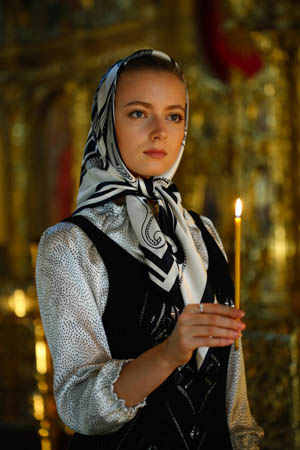Friday, November 28, 2014
Stump the Priest: Head Coverings
Question: "I know many believe women are supposed to cover their heads, but in many parishes, few women observe this. Also, there seems to be a difference of opinion about whether girls should have their heads covered. Is this just a matter of custom, or is there a correct practice?"
St. Paul speaks of women covering their heads when at prayer is 1st Corinthians 11:2-16, in no uncertain terms. The only dispute about this practice in the early Church was at what point in a woman's life was she to begin covering her head. Tertullian wrote about this in his treatise "On the Veiling of Virgins," which was written approximately in 204 a.d. It was the general practice that it was not obligatory for girls who had not reach puberty to cover their heads, and it was the universal practice that married women covered their heads, but some held that adult virgin women did not need to cover their heads. Tertullian argued against that position, and argued that all women should cover their heads once they had reached puberty. It has also been the custom in parts of the Church for girls of any age to have their heads covered.
It was even the practice for women to cover their heads in Protestant churches up until about the 1960's -- I remember seeing many women still observing this as a child growing up in Protestant Churches. But even today, some Protestants, many Catholics, and most Orthodox continue to observe this apostolic practice.
My opinion on this is that while it is clearly the Tradition for all women above the age of puberty to cover their heads, I think it is a good idea for Orthodox families to adopt the practice of covering the heads of younger girls as well, simply because if you do not get a young girl in the practice of covering her head in our culture, the chances that she will ever observe that practice is dramatically reduced.
In our own parish, as with a number of other issues, we ask people not to take up the task of enforcing this tradition on anyone else. We simply hope that those who do not observe this practice will be inspired by those who do, to change voluntarily. But in our culture, if we were to beat people over the head on such matters the first time they walked into the Church, there is little chance they would stick around long enough to be convinced to do anything differently.
Update:
Some people have asked why, since this same passage says men should keep their heads uncovered at prayer, clergy are allowed to wear things like skufias, kamilavkas, and mitres? The passage speaks generally about men. It does not address clergy. You find head gear for the priests in the Old Testament, also in the book of Revelation in the heavenly worship (4:4 and 4:10), and also Church tradition tells us that St. John wore a mitre during the services (see Eusebius, Ecclesiastical History 3:31:3 and 5:24:2. These hats are signs of rank and honor, but even bishops are obliged to remove their mitres at the most important parts of the service. Only women keep their heads covered throughout the service, and so you could say that they have the highest award when it comes to head coverings.
For more information, see:
Uncovering the Truth: Head Coverings and Revisionist Biblical Interpretation
Stump the Priest: Because of the Angels
On Account of the Angels: Why I Cover My Head
Women’s Headcoverings
The Trouble with Head Coverings
St. John Chryostom's Homily on 1 Corinthians 11:2-16
The Woman’s Headcovering, by Michael Marlow (a Protestant article, but very interesting)
